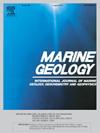Deep Secrets: Discovery of a giant mega-slide in the North Sea Fan, offshore Norway
IF 2.2
3区 地球科学
Q2 GEOSCIENCES, MULTIDISCIPLINARY
引用次数: 0
Abstract
The Mid-Norwegian continental margin is home to multiple submarine landslides of prodigious volume (mega-slides), thought to have occurred once each glacial cycle over the last ∼500 kyr. Here, we present new 2D seismic reflection data that image the headwall of a previously unknown mega-slide buried beneath Quaternary sediment in the North Sea Fan. The deposits linked to this mega-slide, named the Solsikke Slide, have a volume exceeding 15,000 km3. This is five times greater than the neighboring tsunamigenic Holocene Storegga Slide's volume, and makes the Solsikke Slide one of the largest landslides yet discovered on our planet. The Solsikke Slide remobilized deposits from the previous three mega-slides within the North Sea Fan, including the Tampen Slide that is thought to have occurred ca. 120 kyr BP. Together with the overlying deposits, this constrains the timing of the Solsikke Slide to between 120 and 57 kyr BP (MIS 5–3), which indicates that mega-slides may happen more frequently than previously thought along this margin. Furthermore, we identify a network of faults that extend up from the acoustic basement to the base of the Solsikke headwall, and seismic evidence of lateral fluid migration within the underlying unit. These observations suggest seismic shaking and fluid migration, together with sediment loading, likely played an important role in pre-conditioning and/or triggering failure. Our findings thus have significant implications for understanding the hazard posed by mega-slides in the Northern Atlantic, in terms of their frequency, potential magnitude, and pre-conditioning factors.
深层秘密:在挪威近海的北海扇发现了一个巨大的巨型滑坡
挪威中部大陆边缘是多个巨大体积的海底滑坡(巨型滑坡)的家园,据信在过去~ 500万年的每个冰川循环中发生一次。在这里,我们展示了新的二维地震反射数据,该数据显示了埋藏在北海扇第四纪沉积物下的一个以前未知的巨型滑坡的顶壁。与这个巨型滑坡相连的沉积物被命名为索尔西克滑坡,其体积超过15,000立方千米。这比邻近的海啸成因全新世的斯托尔加滑坡的体积大五倍,使索尔斯克滑坡成为我们星球上迄今为止发现的最大的滑坡之一。Solsikke滑坡从北海扇内的前三次巨型滑坡中重新移动了沉积物,包括被认为发生在距今120万年左右的Tampen滑坡。加上上覆的沉积物,这限制了索斯克滑坡的时间在120至57千BP之间(MIS 5-3),这表明沿这一边缘发生巨型滑坡的频率可能比以前认为的要高。此外,我们还发现了一个从声学基底向上延伸到Solsikke井壁底部的断层网络,以及下伏单元内横向流体运移的地震证据。这些观测结果表明,地震震动和流体运移以及沉积物载荷可能在预调节和/或触发破坏中发挥了重要作用。因此,我们的研究结果对了解北大西洋巨型滑坡所造成的危害具有重要意义,包括其频率、潜在震级和预条件因素。
本文章由计算机程序翻译,如有差异,请以英文原文为准。
求助全文
约1分钟内获得全文
求助全文
来源期刊

Marine Geology
地学-地球科学综合
CiteScore
6.10
自引率
6.90%
发文量
175
审稿时长
21.9 weeks
期刊介绍:
Marine Geology is the premier international journal on marine geological processes in the broadest sense. We seek papers that are comprehensive, interdisciplinary and synthetic that will be lasting contributions to the field. Although most papers are based on regional studies, they must demonstrate new findings of international significance. We accept papers on subjects as diverse as seafloor hydrothermal systems, beach dynamics, early diagenesis, microbiological studies in sediments, palaeoclimate studies and geophysical studies of the seabed. We encourage papers that address emerging new fields, for example the influence of anthropogenic processes on coastal/marine geology and coastal/marine geoarchaeology. We insist that the papers are concerned with the marine realm and that they deal with geology: with rocks, sediments, and physical and chemical processes affecting them. Papers should address scientific hypotheses: highly descriptive data compilations or papers that deal only with marine management and risk assessment should be submitted to other journals. Papers on laboratory or modelling studies must demonstrate direct relevance to marine processes or deposits. The primary criteria for acceptance of papers is that the science is of high quality, novel, significant, and of broad international interest.
 求助内容:
求助内容: 应助结果提醒方式:
应助结果提醒方式:


